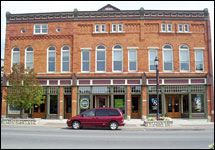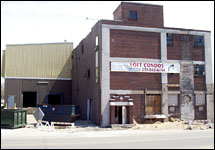MLUI / Articles from 1995 to 2012 / Four Up-North Success Stories
Four Up-North Success Stories
Brownfield revivals yield mushrooms, main street center, new city hall, and a park
November 10, 2005 |
 | |
| Mac McClelland | |
East Jordon’s downtown revival. |
Mason County: Hi-Tech Mushrooms
Just as he’s mastered fast-moving advances in the biotechnology that underpins his company’s success, Gary Mills has likewise figured out how to make Michigan’s brownfield redevelopment program work for his company and county.
In October 2003, Mr. Mills established Diversified Natural Products Inc., a biotechnology company, in an abandoned Chiquita bean processing plant in Scottville, a Mason County farm town east of Ludington. His proposal to invest $9 million in growing gourmet mushrooms was enthusiastically embraced by the county, which lost more than 400 manufacturing jobs in the last decade.
That initial investment, he said, would eventually lead bio-based fuel and chemical production, as well as other natural food products. Part one of the ambitious plan, growing mushrooms, would generate 51 new jobs.
Much of Mr. Mills’ proposal hinged on attracting a $750,000 brownfield single business tax credit to defray the cost of demolishing the old plant and cleaning up fuel leaking from tanks there. In April 2004, the state awarded the tax credit, lauding the company as a prime example of the entrepreneurial spirit that the brownfield program encouraged. The company also benefits from capturing roughly $350,000 in local taxes for environmental cleanup.
Diversified Natural Products is now establishing itself as a bona fide player in the industrial biotechnology economy and is planning to expand one facility to make “bio-based polymers” for plastics, a project it is undertaking with a French company.
 | |
| Mac McClelland | |
| Under reconstruction: Ludington’s Harbor Terrace condominiums. |
“Brownfield redevelopment has become a cornerstone of our community economic development strategy,” said Bill Kratz, the director of the Mason County Economic Development Corporation.
East Jordan: A Main Street Revival
When East Jordan’s early 21st-century history is written, Floyd Wright may well have earned himself a video fountain or a laser statue. Mr. Wright, a Boyne City builder, is turning two century-old landmarks in downtown East Jordan — the Porter Lumber Company and the Vortuba Hardware Store — into a modern retail and office center. The three-story project, a lynchpin of East Jordan’s redevelopment plan, has gained recognition from the State Historic Preservation Office.
The Porter Lumber Company building, once a stately office building, had fallen into disrepair in this town of 2,500. Most thought the building should just be torn down. But Mr. Wright, city manager Dave White, and economic development director Rod Benson thought that the building could catalyze downtown revitalization.
In 1999, Mr. White helped establish the East Jordan Brownfield Redevelopment Authority to guide brownfield redevelopment grants, loans, and credits to Mr. Wright and other East Jordan historic preservationists.
“We knew there were opportunities and Floyd came in with just the right project,” he said.
The $2.55 million effort, which generated 30 new jobs, was helped by persistent historic preservationists and a $255,000 state brownfield single business tax credit. “The availability of the tax credit was a critical factor,” said Mr. Wright. “It helped attract our partner, Charlevoix State Bank, which was looking for a presence here, to the project.”
Frankfort and Elberta: Reviving Betsie Bay
 | |
| Keith Schneider/MLUI | |
| Frankfort’s new city hall. |
What most accounts for this growing civic wealth and hard-earned stability are Frankfort’s business and political leaders, who understand that their Lake Michigan town days as a lumber, shipping, and agricultural center are over. They see the town’s scenic waterfront and small-town charm as the basis of Frankfort’s new economy, but the old economy left behind some brownfields and blighted properties that needed cleaning up.
So Frankfort decided to enhance and redevelop the properties, improve city parks, and attract new businesses. The city established a brownfields redevelopment authority in 2000 with tax increment financing jurisdiction to implement assessment, cleanup, and redevelopment. The authority garnered what may be the greatest amount of discretionary federal dollars per capita of any northern Michigan community.
In 2000, Frankfort received a $200,000 EPA brownfield redevelopment pilot grant to help city officials assess and prepare five brownfield parcels for redevelopment along Betsie Bay, the city’s harbor. Two years later, the EPA provided another $150,000 brownfield grant to continue the work. In 2003, the federal Department of Agriculture awarded Frankfort a $1.3 million rural development loan to develop a new city hall. Lastly, the state awarded Frankfort $680,000 for new parks, street beautification, and a new bicycle trail that runs along Betsie Bay. Today the town attracts all kinds of new home and business investment.
Meanwhile, across Betsie Bay, tiny Elberta is also rebooting its economy. The village of 450 people, left with an Ann Arbor Railroad terminal yard that served as its waterfront, recognized the value of brownfield redevelopment and established one of northern Michigan’s first brownfield authorities in 1997. The authority approved a brownfield plan for the railroad yard and bought that land from the state Department of Transportation.
After Elberta received waterfront redevelopment grants from state, federal, and private sources for a marina and waterfront park, it began its transformation into a maritime magnet for new housing, businesses, shops, and restaurants. The park now hosts a two-week Shakespeare festival each summer; the rest of the transformation is well under way.





